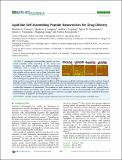Lipid-like Self-Assembling Peptide Nanovesicles for Drug Delivery
Author(s)
Fatouros, Dimitrios G.; Lamprou, Dimitrios A.; Urquhart, Andrew J.; Yannopoulos, Spyros N.; Vizirianakis, Ioannis S.; Zhang, Shuguang; Koutsopoulos, Sotirios; ... Show more Show less
DownloadFatouros-2014-Lipid-like self.pdf (3.080Mb)
PUBLISHER_POLICY
Publisher Policy
Article is made available in accordance with the publisher's policy and may be subject to US copyright law. Please refer to the publisher's site for terms of use.
Terms of use
Metadata
Show full item recordAbstract
Amphiphilic self-assembling peptides are functional materials, which, depending on the amino acid sequence, the peptide length, and the physicochemical conditions, form a variety of nanostructures including nanovesicles, nanotubes, and nanovalves. We designed lipid-like peptides with an aspartic acid or lysine hydrophilic head and a hydrophobic tail composed of six alanines (i.e., ac-A[subscript 6]K-CONH[subscript 2], KA[subscript 6]-CONH[subscript 2], ac-A[subscript 6]D-COOH, and DA[subscript 6]-COOH). The resulting novel peptides have a length similar to biological lipids and form nanovesicles at physiological conditions. AFM microscopy and light scattering analyses of the positively charged lipid-like ac-A[subscript 6]K-CONH[subscript 2], KA[subscript 6]-CONH[subscript 2] peptide formulations showed individual nanovesicles. The negatively charged ac-A[subscript 6]D-COOH and DA[subscript 6]-COOH peptides self-assembled into nanovesicles that formed clusters that upon drying were organized into necklace-like formations of nanovesicles. Encapsulation of probe molecules and release studies through the peptide bilayer suggest that peptide nanovesicles may be good candidates for sustained release of pharmaceutically active hydrophilic and hydrophobic compounds. Lipid-like peptide nanovesicles represent a paradigm shifting system that may complement liposomes for the delivery of diagnostic and therapeutic agents.
Date issued
2014-05Department
Massachusetts Institute of Technology. Center for Biomedical Engineering; Massachusetts Institute of Technology. Center for Bits and Atoms; Massachusetts Institute of Technology. Media LaboratoryJournal
ACS Applied Materials & Interfaces
Publisher
American Chemical Society (ACS)
Citation
Fatouros, Dimitrios G., Dimitrios A. Lamprou, Andrew J. Urquhart, Spyros N. Yannopoulos, Ioannis S. Vizirianakis, Shuguang Zhang, and Sotirios Koutsopoulos. “Lipid-Like Self-Assembling Peptide Nanovesicles for Drug Delivery.” ACS Applied Materials & Interfaces 6, no. 11 (June 11, 2014): 8184–8189. © 2014 American Chemical Society
Version: Final published version
ISSN
1944-8244
1944-8252